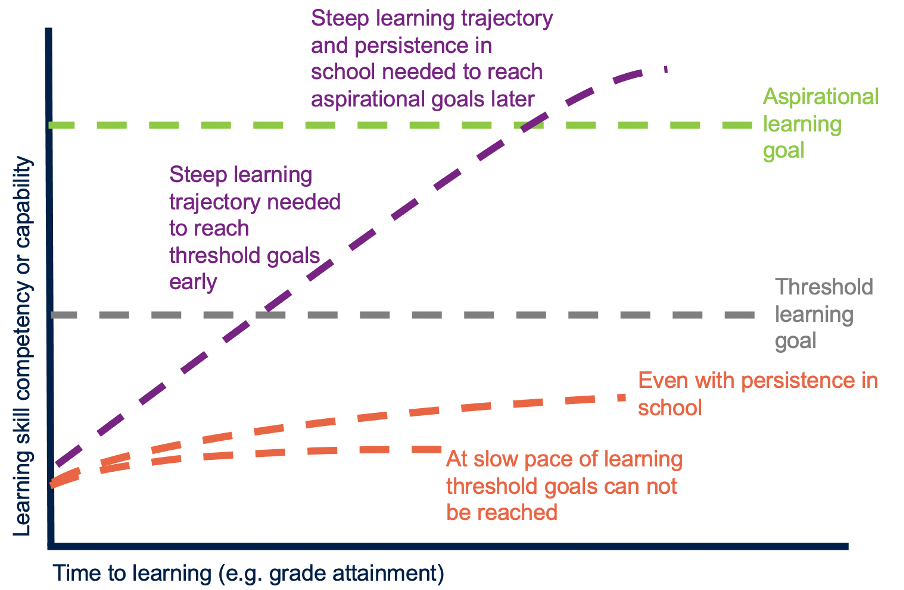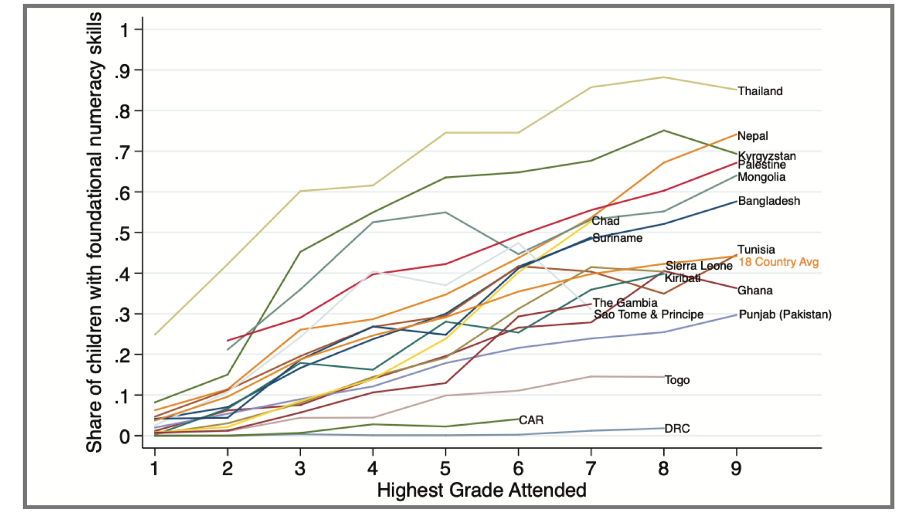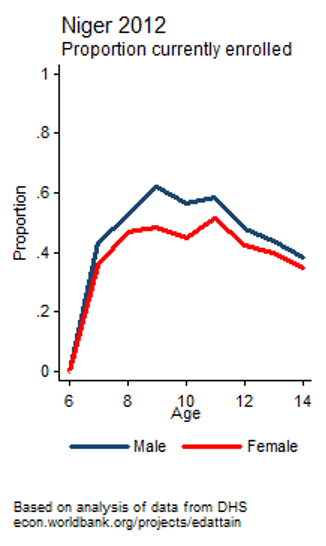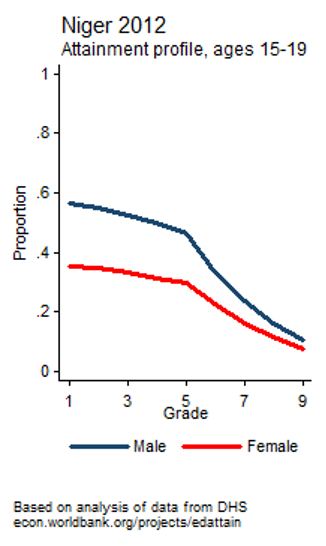Lant Pritchett
Blavatnik School of Government, University of Oxford
Insight Note
There is a growing consensus among national governments and development partners about the importance of girls’ education. This is reflected in the UK government’s commitment to quality education for every girl for 12 years, and in targets for increasing girls’ schooling and learning adopted by the Group of 7 (G-7) countries at their meeting in mid-2021 (G7, 2021).
The emergence of this consensus comes at a critical time. Education systems in low- and middle-income countries are facing a learning crisis, with many systems failing to equip children with the foundational skills they need to reach their full potential.
Within this movement for girls’ education, much attention is focused on the unique challenges adolescent girls face, and on programmes to help girls stay in school. But designing interventions without sufficient understanding of the drivers of adolescent girls’ challenges will leave policy makers frustrated and girls unaided.
To help adolescents reach their full potential, we must first understand what is undermining their progress in the first place. Understanding learning trajectories (how much children learn over time) is key to helping both today’s and tomorrow’s adolescent girls.
This insight note briefly explains what learning trajectories are and then offers six analytical insights about learning trajectories that can inform education systems reforms to ensure that every girl meets her full potential.
For many children in developing countries, learning trajectories are too shallow and flatten out too quickly (Kaffenberger, 2019; Silberstein, 2021). This is partly because young children do not master the basics—particularly literacy and numeracy—and therefore they are unable to benefit from additional years of schooling (Belafi et al., 2020).
Figure 1 shows an illustrative learning trajectory. The grey line represents a threshold learning goal, like the SDG target for minimum literacy and numeracy, and the green line represents an aspirational learning goal, like writing a literary analysis essay (a skill expected of girls in the UK). To reach the aspirational goal, children must pass through the threshold goal. The purple line shows a learning trajectory steep enough to reach the threshold goal, if children stay in school. The orange lines represent two cases that are far too common in low- and middle-income countries: flat learning trajectories leading either to dropout or to persistence in school with little learning.
Learning trajectories often flatten out early in the schooling years. In this instance, children may drop out of school early (the bottom orange curve), but even if children persist in school (the top orange curve), they would not reach the threshold, let alone the aspirational goal. The learning trajectory starts too shallow (too little learning in the early years) and then is too flat, often because the teaching and curriculum race and ahead.
The PISA-D results show that in low performing education systems, like Zambia’s, only 6.5 percent of girls in school at age 15 reach the SDG threshold for reading and only 2.6 percent for mathematics (Pritchett and Viarengo, 2021). A recent survey of Indian youth by ASER shows that even girls with secondary education often cannot answer very basic life-skills questions (ASER, 2018).

While it is not the case that learning trajectories in all countries are too shallow in the early years, and not all learning trajectories flatten out, there is evidence this is the case in most low- and middle-income countries (Silberstein, 2021; Pritchett and Sandefur, 2020).

We need to support today’s primary school girls—who are future adolescents—and ensure that they develop foundational skills. Mastering foundational literacy and numeracy early can launch girls on a steeper learning trajectory, help them stay in school and learning, and put them on a path to fulfil their potential.
The remainder of this note explains six important analytic consequences from shallow learning trajectories that can inform thinking about how to help adolescent girls get the learning, skills, capabilities, and competences they need to thrive as adults.
First, evidence suggests that flat learning trajectories—i.e., low learning—themselves are a cause of dropout. Qualitative interviews conducted with children in the Young Lives panel survey show that girls—and boys—drop out of school because they realise they are not getting anything out of their schooling experience and so they seek a different path towards a secure future, such as marriage or employment (Kaffenberger et al., 2021a). Quantitative analysis of this panel finds that the odds of girls dropping out fall by 40 percent for every one standard deviation increase in their math scores (Kaffenberger et al., 2021b). Results from the PISA for Development surveys also indicate that low learning is also a driver of dropout for many children. For example, parents of more than 40 percent of 15-year-olds who are out of school in Senegal report that poor grades were the reason that their child left school (Ward, 2020).
Moreover, being in a classroom without being able to understand what is being taught is an unproductive, disheartening experience (Kaffenberger et al., 2021a). A learning trajectory that is steeper at its beginning implies that it will flatten out later than a learning trajectory that starts out flat, and hence girls will stay in school longer because they are learning more.
Second, if girls have dropped out because they are learning too little then programmes that induce those girls to stay in school under those same learning conditions are unlikely to produce the intended learning outcomes. For instance, a “conditional cash transfer” may provide adequate incentive for a girl to stay in school, but if the girl is on a flat learning trajectory then the gains from that additional schooling will be smaller than the existing estimates of the “average” gains from a year of schooling. A recent paper looked at this issue using an RCT with long-term follow-up of two different types of support for girls to stay in school in Cambodia, one a “scholarship” based on performance and one a transfer based on need. While both induced girls to stay longer in school, only the academic performance-based scholarship had any long-term impact on learning or on later life outcomes (Barrera-Osorio et al., 2019). If girls have dropped out because the education system is failing to provide an environment in which they can learn, it is unjust and ineffective to blame the girl and/or her family for the decision to drop out and to assume that just inducing the girl to stay in school is all that needs to happen. Instead, programmes should combine efforts to bring adolescents back into school with efforts to help them catch up on what they have missed and make further learning progress.
Interpretations of studies that show large benefits from expanding girls’ schooling need to be based on an understanding of the learning trajectory of the girls in the study, who were enabled or induced to attend school for longer because of an intervention. So, for instance, a study showing that extending scholarships to girls whose learning assessments make them eligible for higher education (who are therefore near the top of the distribution of learners) has high benefits might be correct about that specific population, but this doesn’t imply that extending schooling of girls has high learning returns in all situations.
Third, the flatness of the learning trajectories at higher grades is often because the teaching and curriculum move ahead faster than many or even most children’s learning trajectories (Hwa et al., 2020). A forthcoming study in Rajasthan found that the typical child in Grade 8 was at Grade 4 levels of understanding—and many were still at Grade 2 and 3 levels of proficiency. This study also shows that approaches that “Teach at the Right Level” by adjusting instruction to the child’s level of understanding (in this study this is done with computerised instruction, but this can also be done without computers) led to much larger learning gains (Muralidharan and Singh, forthcoming). All this suggests that as one designs programmes to prevent dropout or encourage girls to re-enrol, the question has to be raised and addressed: “How will the programme enable the girl to learn, starting from the levels of capability she currently has?”
Fourth, there is often the expectation and reality that there are “threshold effects” in learning driven by “choke points” in a system with high stakes for the student examinations. For instance, many education systems have Grade 10 examinations and a “Grade 10 pass” is necessary for further education or is a requirement for formal sector (public sector) jobs. If a girl has dropped out because she believes she is not on a trajectory to reach a threshold, then programmes aimed at supporting adolescent girls need to directly address that reality.
Suppose a girl has dropped out in Grade 8 because she correctly perceives that she will not, on her current learning trajectory in the schooling and learning conditions available to her, reach Grade 10 and pass the Grade 10 exam, and she correctly believes many of the benefits of education come from passing Grade 10. In that case it is of limited benefit to induce or force that girl (on threat of losing safety net benefits her family is otherwise eligible for) to stay in Grade 9 and 10 without also enabling her to pass the Grade 10 exam. Again, the goal is not to “get girls to stay in school”; the goal is to “prepare girls for a successful life”. This has to be based on realism about learning trajectories and what is needed to improve them.
Fifth, one can visualise learning trajectories by age or learning trajectories by grade (as shown in Figure 3). The learning trajectory by age depends on whether the child is enrolled, and the amount learned if enrolled. One serious issue for many countries with rural populations and low-performing education systems (shallow early learning trajectories) is that children (sometimes especially girls) enrol in school late (not at first eligible age of 6, but often not until age 8 or 10). Programmes aimed at helping girls often assume that the challenge facing a 15-year-old girl is whether or not to persist into senior high school (e.g., go on to Grade 9 or 10). But often the challenge for a 15-year-old girl is that she did not enrol until she was nine, she repeated first grade (perhaps because even at age 9 she was not school-ready), and she was in a school with weak teaching and learning conditions and hence was on a shallow learning trajectory. By age 15 she is only in Grade 6 and may not truly have mastered even foundational skills yet. The challenge of low grade attainment is not dropout but late enrolment. More focus on school readiness and on-time enrolment of girls at ages 5 and 6 would then lead to more girls at age 15 who are further along in grade and learning achievement, and perhaps less likely to drop out.


Sixth, efforts to help adolescents and young women transition from school to work cannot ignore their foundational skills. Work and job skills such as vocational skills, digital literacy, entrepreneurial capabilities, and other workforce readiness skills rest on a core basis of foundational skills in literacy and numeracy (Arias et al., 2019). Technical and vocational trainings to help with the transition to work can complement and build on, but not replace these core skills. Programmes that aim to help with the transition to work need to take learning trajectories into account in their design.
Girls in different countries, regions, and socio-economic groups face different challenges in their schooling and learning. Programme design needs to be based on an analytically and empirically correct understanding of the multitude of situations and options facing adolescent girls from different countries, regions, and family backgrounds and how those circumstances affect learning trajectories.
There are girls who have high potential, high achievement, and a steep learning trajectory who are forced out of school either due to prejudice, discrimination, exclusion, or cultural barriers. There are girls for whom the benefits of additional education would be high, but their families cannot afford or finance that education. But there are also many girls who were not school ready at the first eligible age, whose only available schools provide little learning, who are abandoned by an enacted curriculum that races ahead and leaves them behind. They then see little benefit to staying in school. Helping those girls is important too and cannot be accomplished simply by expanding grade attainment at adolescent ages along existing learning trajectories. Helping all adolescent girls (both current and future) will require both more focus on early learning and programmes specifically tailored to promote the learning of girls who drop out or are at risk of dropping out in adolescence.
Arias, O., Evans, D.K., and Indihar, S. 2019. The Skills Balancing Act in Sub-Saharan Africa : Investing in Skills for Productivity, Inclusivity, and Adaptability. Africa Development Forum;. Washington, DC: World Bank and Agence française de développement. https://openknowledge.worldbank.org/handle/10986/31723 License: CC BY 3.0 IGO.
ASER. 2018. “Annual Status of Education Report 2017: Beyond Basics.” http://www.asercentre.org/Keywords/p/315.html
Barrera-Osorio, F., de Barros, A. and Filmer, D. 2019. Long-Term Impacts of Alternative Approaches to Increase Schooling: Experimental Evidence from a Scholarship Program in Cambodia. https://riseprogramme.org/sites/default/files/inline-files/Barrera-Osorio.pdf
Belafi, C., Hwa, Y., and Kaffenberger, M. 2020. Building on Solid Foundations: Prioritising Universal, Early, Conceptual and Procedural Mastery of Foundational Skills. RISE Insight Series. 2020/021. https://doi.org/10.35489/BSG-RISE-RI_2020/021
G7. 2021. “G7 Foreign and Development Ministers’ Communiqué.” G7 UK Presidency 2021 (blog). 2021. https://www.g7uk.org/g7-foreign-and-development-ministers-meeting-may-2021-communique/
Hwa, Y., Kaffenberger, M. and Silberstein, J. 2020. Aligning Levels of Instruction with Goals and the Needs of Students (ALIGNS): Varied Approaches, Common Principles. RISE Insight Series. 2020/022. https://doi.org/10.35489/BSG-RISE-RI_2020/022
Kaffenberger, M.2019.A Typology of Learning Proiles: Tools for Analysing the Dynamics of Learning. RISE Insight Series.2019/015. https://doi.org/10.35489/BSG-RISE-RI_2019/013
Kaffenberger, M., Sobol, D. and Spindelman, D. 2021a. The Role of Low Learning in Driving Dropout: A Longitudinal Mixed Methods Study in Four Countries. RISE Working Paper Series. 21/070. https://doi.org/10.35489/BSG-RISE-WP_2021/070
Kaffenberger, M., Sobol, D., Spindelman, D. and Spivack, M. 2021b. “To Increase Girls’ Schooling, Improve Girls’ Learning.” RISE Programme. Accessed August 3, 2021. https://riseprogramme.org/blog/increase-girls-schooling-improve-girls-learning
Muralidharan, K. and Singh, A. Forthcoming. “Improving Schooling Productivity through Computer-Aided Personalization: Experimental Evidence from Rajasthan.”
Pritchett, L. and Viarengo, M. 2021. Learning Outcomes in Developing Countries: Four Hard Lessons from PISA-D. RISE Working Paper Series. 21/069. https://doi.org/10.35489/BSG-RISE-WP_2021/069
Pritchett, L. and Sandefur, J. 2020. “Girls’ Schooling and Women’s Literacy: Schooling Targets Alone Won’t Reach Learning Goals.” International Journal of Educational Development 78 (October): 102242. https://doi.org/10.1016/j.ijedudev.2020.102242
Silberstein, J. 2021. Measuring, Visualising, and Simulating Solutions to the Learning Crisis: New Evidence from Learning Profiles in 18 Countries. 2021/029. https://doi.org/10.35489/BSG-RISE-RI_2021/029
Ward, M. 2020. “PISA for Development: Out-of-school assessment: Results in Focus”, PISA in Focus, No. 110, OECD Publishing, Paris, https://doi.org/10.1787/491fb74a-en
Pritchett, L. and Spivack, M. 2021. Understanding Learning Trajectories Is Key to Helping Adolescent Girls. 2021/032. https://doi.org/10.35489/BSG-RISE-RI_2021/032